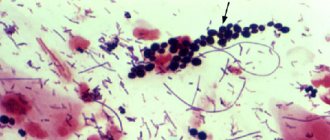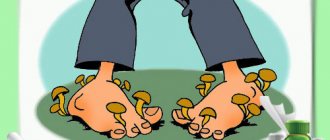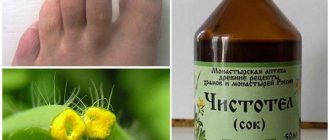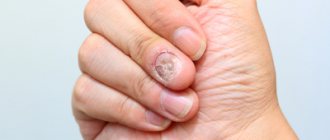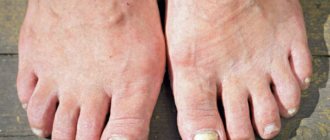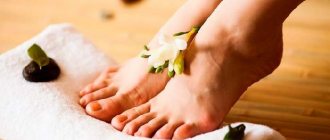Foot fungus (mycosis) is one of the most common mycotic diseases that causes redness, peeling and itching of the skin of the feet. If left untreated, a fungal infection causes deformation, changes in color and structure of the nail plates. In addition to visible cosmetic defects and discomfort, advanced mycosis reduces immunity, provokes allergic rashes and exacerbation of chronic diseases.
- REASONS FOR DEVELOPMENT
- FORMS OF MYCOSIS (FOOT FUNGUS)
- ONYCHOMYCOSIS (NAIL FUNGUS)
- DIAGNOSTICS
- EFFECTIVE TREATMENT OF FOOT FUNGUS
- VIDEO REVIEW OF PINPOINTE LASER FOR TREATING FUNGUS (the only one in Moscow)
- VIDEO REVIEW OF THE DEVICE FOR PHOTODYNAMIC PROCESSING RAST
- PHOTOS BEFORE AND AFTER TREATMENT AT THE PODOLOGY CLINIC
Symptoms, signs and diagnosis
It is very important not to miss the first signs of fungus on the hands, which are expressed:
- Peeling of the skin and persistent itching;
- Peeling of the skin, especially between the fingers;
- The appearance of bubbles and swellings in areas affected by mycosis;
- Increased sweating of the palms;
- Changes in skin structure, deformation of nails;
- Various spots on the nails and their peeling;
- Since the fungus can penetrate the human body, pain in different organs is possible.
Diagnosing fingernail fungus is the task of a dermatologist. You should not diagnose yourself and try to solve the problem alone, as this requires taking a scraping for laboratory testing.
What is skin and nail fungus?
The term “fungus” refers to a whole complex of various diseases and pathogens. But usually we are talking about only some types of fungus:
Dermatomycosis.
Caused by the fungi Trichophyton, Microsporum and Epidermophyton. Affects the skin and sometimes nails. At first it may not seem serious, because the first symptoms are:
- the appearance of pink or red spots on the body that have a clear shape and pigmentation around the perimeter;
- itching at the site of the spots, which does not always appear.
If you do not consult a doctor in time and do not prescribe the correct treatment, then the symptoms can become much more serious:
- the appearance of dandruff;
- baldness of affected areas;
- the occurrence of suppuration;
- uncontrolled increase in the area of affected areas.
Onychomycosis.
Caused by the fungi Trichophyton rubrum, Trichophyton interdigitale, Trichophyton tonsurans. It affects the nails and is the most common type of fungal infection. It has the following symptoms that appear as the fungus develops:
- the nail begins to turn yellow;
- the nail becomes exfoliated and thickens;
- an unpleasant odor appears that cannot be eliminated by any means;
- the plate becomes deformed, irregularities and “waves” appear;
- the nail completely dies and “falls off” from the finger.
Treatment of fungus on hands
It is necessary to begin treatment with laboratory tests to determine the type of fungal disease. The study will allow us to determine the necessary and effective drug that will successfully combat the detected type of pathogen. In the early stages, mycosis can be successfully treated with antifungal medications - sprays, lotions, creams and ointments. All of these medications have contraindications, so before starting treatment, you need to consult your doctor and follow his instructions.
Fungus on hands photo
Why can skin and nail fungus be dangerous?
Fungus of the skin and nails can occur either as an independent disease or as a consequence of existing ones. For example, frequent fungal infections may indicate problems such as:
- presence of viral hepatitis;
- HIV infection;
- a general decrease in immunity, which can cause the development of very serious diseases.
In addition, the development of fungus can cause serious harm to health and reduce the quality of life. With endless itching, it is impossible to concentrate on daily activities, and sores on exposed parts of the body can be a deterrent for many.
Moreover, the fungus is easily transmitted to other people, and being a source of infection is unpleasant, to say the least. By the way, if you notice symptoms of fungus, you should not visit public places with conditions favorable for its development: saunas, swimming pools, cosmetology and beauty salons.
Pharmacy remedies for fungus on hands
help well in treating fungus on the hands . To be effective, they need to remain on the affected area for as long as possible. For this purpose, medicinal varnish is also used. Loceryl and Batrafen are considered the most effective: before using them, you need to remove the infected piece of nail with a file or nail clippers.
In the early stages of the disease, it is good to use patches with a peeling effect. When used, the affected area of the nail softens and can then be easily removed. It contains salicylic acid, urea, an antiseptic and an antifungal agent. This patch is wrapped in a simple plaster, left for a couple of days, after which the procedure is repeated. Such treatment will require at least six months.
Fungus on the fingers or between the fingers is treated with medical formulations according to prescriptions, which you can make yourself, knowing the exact composition of the medications. They usually contain vinegar essence, sulfur, iodine, salicylic and lactic acid, brilliant green and blue. Treatment with such drugs is quite long-term and can last more than a year.
New drugs are now available that actively destroy the fungus. The duration of treatment with these drugs is from 2 to 4 months. The most effective is pulse therapy, which lasts only a few weeks. Common medications for oral administration are tablets and capsules. But all drugs can be used only as prescribed by a doctor.
Medicines for mycosis:
- Diflucan
- Mycohepitn
- Clotrimazole
- Fluzol
- Fluconazole
Ointments and solutions:
- Levorin ointment
- Griseofulvin
- Triderm
- Nystatin ointment
- Mycozolon
Reasons for development
Foot fungus is caused by pathogenic and opportunistic fungi. The most important causative agents of the disease include molds Aspergillus, Scopulariopsis, yeast-like fungi Candida and dermatophyte fungi of the genera Trichophyton, Microsporum and Epidermophyton. The penetration of the fungus is facilitated by microtraumas of the skin, its excessive dryness, or vice versa, sweating.
An equally important factor is reduced immunity, various neurohumoral, endocrine, vascular and other disorders of the body. Typically, the transmission of fungal infection occurs through shared towels and washcloths, as well as when visiting swimming pools, baths and saunas without special shoes (flip-flops, slates).
Traditional medicine against fungus on hands
such remedies for fungus on the hands , the most effective ones are listed below.
Coffee:
- Brew strong coffee without throwing away the sediment.
- Several times during one procedure, lower and hold your hands in warm coffee.
Hot pepper:
- Cut off the bottom of the hot pepper, remove the seeds.
- Pour strong vodka into it.
- Dip the affected finger into the vodka, being careful not to let the vodka spill out.
- Leave for 10-20 minutes, remove the finger and bandage it.
- The bandage must be left overnight.
The process is very painful, but recovery occurs quickly.
Sea salt baths:
- Add 2 tbsp to 2 liters of warm water. l. salt. Mix.
- Systematically hold your hands in a warm solution for 20 minutes a day.
hand fungus
Forms of mycosis (foot fungus)
There are several forms of mycosis of the skin of the feet:
- Squamous
- characterized by peeling of the arch of the foot, which gradually spreads to the flexor and lateral surfaces of the toes. Areas of thickening of the epidermis may appear on the skin. - Intertriginous
- in appearance it resembles interdigital diaper rash with a whitish coating. The fungus mainly affects the third and fourth interdigital spaces, causing peeling, cracking and itching of smooth skin. - Dyshidrotic
- “sago grains” are formed on the arches of the feet - bubbles with transparent contents, which can be either isolated or merge into multi-chambered bubbles. Gradually they open up, forming erosions bordered by flaky epithelium, and if an infection occurs, they become covered with purulent crusts. - Erased
- the spaces between the first and second or fourth and fifth toes are affected. The infected areas of the skin begin to peel off, the skin grooves look as if they were drawn with chalk.
In advanced cases, the fungus invades the nail plates of the toes, as a result of which they change their color, begin to crumble and peel off from the nail bed.
Prevention
We should never forget that mycosis is a contagious disease, and if one family member is infected, then, as a rule, everyone else becomes infected. Therefore, you must always strictly follow the rules of hygiene:
- Do not use someone else’s shoes and do not give yours to anyone;
- The infected family member should have separate manicure supplies;
- If you are infected, do not walk around your apartment barefoot.
- Perform daily disinfection of everything the patient has touched;
- Try not to wear socks and tights for a long time.
In order not to become infected with such an unpleasant disease, you should try to avoid visiting public health centers - baths, showers and swimming pools. Carefully monitor personal hygiene and prevent fungal diseases, and immediately consult a doctor at the first symptoms.
Causes of fungal diseases of the skin and nails
Here are just the most basic reasons for the appearance of fungus on the skin or nails:
1. Lack of hygiene.
You don't have to go weeks without showering to get fungus. Sometimes it’s enough to not wash your feet once after a hard day at work. Especially if your feet sweat in shoes, as happens, for example, in winter boots.
2. Dirty floor at home.
In our standard apartments, the hallway is a transit area where people walk around both wearing shoes and barefoot. Dirt brought from the street can contain absolutely any microorganisms, and not everyone is ready to wash the floor every evening. Therefore, it is best to wear slippers at home.
3. Public saunas and swimming pools.
There is no need to refuse to visit the pool or sauna: their benefits for the body have long been proven by hundreds of studies. But it’s definitely not worth walking there barefoot or sitting on surfaces without a towel.
4. Contact with animals.
You shouldn’t be afraid to touch your cat or dog, but it’s better not to let them play with stray animals and always wash their paws after walks. And if you pet an unfamiliar pet on the street, be sure to immediately wash your hands with soap or use an antiseptic: fortunately, today its presence is a new form of etiquette.
5. Contact with soil or sand.
Walking barefoot on the hot sand on the seashore or on the warm earth by a cool river is something worth waiting for summer for or going to warm countries for. But this pleasure can easily turn into a trip to the dermatologist: public beaches are almost the main breeding grounds for fungus. If the surfaces in the pool are washed and treated, then this is definitely not done with sand or earth. We advise you to buy beautiful slates and not worry about your health.
Fungus on feet
Fungus on the feet can be localized on the skin of the feet (dermatomycosis) and on the nails (onychomycosis). Pathogenic fungi are transmitted from a sick person to a healthy person. Often, infection with mycosis occurs within a family, when one of its members does not notice signs of infection for a long time and gradually infects the rest of the family members.
Most often, the cause of infection is direct contact with an infected person or with objects he uses (shoes, clothes, carpets, washcloths, manicure or pedicure accessories). Infections can occur when visiting public places: gyms, fitness centers, baths, saunas or swimming pools.
Infection and development of the disease are facilitated by damage to the skin, microcracks, excessive moisture or dry skin. A particular danger is maceration and microcracks in the interdigital space.
Mycosis can also develop in the presence of diseases of the endocrine system (diabetes mellitus, obesity, hypothyroidism), vascular diseases of the extremities (venous insufficiency, lymphostasis), immune disorders, as well as when taking antibiotics, corticosteroids and cytostatic drugs. All this leads to disruption of blood microcirculation in the nail area, decreased immunity, and therefore infection.
Mycosis on the feet (onychomycosis) is caused by the following types of fungi:
- dermatophytes;
- fungi of the genus Candida;
- mold fungi.
Depending on the type of pathogen, the spread of infection and its clinical picture will be different, therefore, approaches to therapy will also differ.
Onychomycosis is very common. Moreover, the disease occurs 1.5 times more often in men than in women.
Toenails are affected by fungus 10 times more often than fingernails.
Symptoms of nail fungus
- change in the color of the nail plate to yellow, black, green or gray;
- separation of the nail plate from the nail bed;
- changes in the thickness and structure of the nail;
- changes in the skin on the nail folds, their inflammation.
Mycosis of the feet or dermatophytosis is a skin disease of the feet caused by pathogenic or opportunistic fungi. Infection of the skin on the feet is accompanied by peeling and itching. In severe cases of the disease, against the background of red and swollen skin, erosions, cracks appear on the sole and in the interdigital space, which are accompanied by pain.
According to the World Health Organization (WHO), about 1/3 of the world's population is infected with fungi, mycoses of the feet are the most common of them, the incidence is growing from year to year.
According to Russian dermatologists, about 20% of the adult population of our country suffer from mycoses of the feet. At the age of over 70 years, mycosis of the feet is registered in every second patient.
Today, millions of people are already affected by this disease.
The most common causes of mycosis of the feet are dermatomycetes fungi, but sometimes mycosis can also be caused by fungi of the genus Candida.
Risk factors
- external: microtraumas of the skin of the feet (calluses, corns), cracks, hyperhidrosis, narrow shoes, violation of hygiene rules;
- internal: varicose veins and vegetative-vascular dystonia, poor circulation of the skin of the feet; hypovitaminosis; taking antibacterial and other drugs that reduce immunity.
Symptoms of mycosis of the feet
- itching;
- microcracks;
- erythema;
- peeling;
- keratinization of the skin;
- unpleasant odor;
- discomfort, burning and pain.
The first signs of mycosis of the feet appear in the form of itching and burning in the interdigital folds of the feet, the skin begins to peel, crack, turn red, and signs of swelling and inflammation appear. Complications such as diaper rash or skin eczema may develop.

